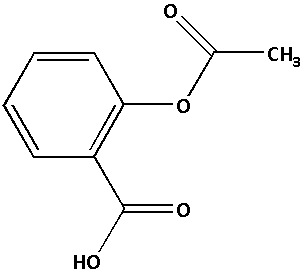
Answer
432k+ views
Hint: To solve this first calculate the actual concentration of aspirin acid in disprin. The concentration of aspirin acid will be equal to the concentration of hydrogen ion in the aqueous solution of disprin. Then from the concentration of hydrogen ion calculate the pH. Remember that aspirin acid is a weak acid.
Complete solution:
We are given that disprin consists of $75\% $ of aspirin acid. And two tablets of disprin of $1.2{\text{ g}}$ each are dissolved in $1{\text{ litre}}$ of water. Thus,
Amount of aspirin acid present in a $1.2{\text{ g}}$ tablet of disprin $ = \dfrac{{75}}{{100}} \times 1.2{\text{ g}}$
Amount of aspirin acid present in a $1.2{\text{ g}}$ tablet of disprin $ = 0.9{\text{ g}}$
Now, $1.2{\text{ g}}$ tablet of disprin is dissolved in $1{\text{ litre}}$ of water. Thus,
Concentration of aspirin acid $ = \dfrac{{{\text{0}}{\text{.9 g}}}}{{1{\text{ L}}}}$
Concentration of aspirin acid $ = {\text{0}}{\text{.9 M}}$
The concentration of aspirin acid is equal to the concentration of hydrogen ion in the aqueous solution of disprin. Thus,
Concentration of hydrogen ion $ = {\text{0}}{\text{.9 M}}$
Calculate the $p{K_a}$ of aspirin acid using the equation as follows:
$p{K_a} = - \log {K_a}$
Where ${K_a}$ is the dissociation constant of acid.
We are given that ${K_a}$ of aspirin acid is ${10^{ - 2}}$. Thus,
$p{K_a} = - \log \left( {{{10}^{ - 2}}} \right)$
$p{K_a} = 2$
The equation to calculate the pH of a weak acid is as follows:
${\text{pH}} = \dfrac{1}{2}\left( {p{K_a} - \log C} \right)$
Where $C$ is the concentration of the weak acid.
Substitute 2 for the $p{K_a}$ of aspirin acid, ${\text{0}}{\text{.9 M}}$ for the concentration of aspirin acid. Thus,
${\text{pH}} = \dfrac{1}{2}\left( {2 - \log \left( {{\text{0}}{\text{.9 M}}} \right)} \right)$
${\text{pH}} = \dfrac{1}{2}\left( {2 - \left( { - {\text{0}}{\text{.04575}}} \right)} \right)$
${\text{pH}} = \dfrac{1}{2}\left( {2.04575} \right)$
${\text{pH}} = 1.02 \approx 1.1$
Thus, the pH of resultant aqueous solution is 1.1.
Thus, the correct option is (A) 1.1.
Note:If the pH is less than 7 then the solution is acidic. If the pH is more than 7 then the solution is basic or alkaline. If the pH is equal to 7 then the solution is neutral. Here the pH of the solution of disprin is 1.1 which means that the solution is acidic in nature.
Complete solution:
We are given that disprin consists of $75\% $ of aspirin acid. And two tablets of disprin of $1.2{\text{ g}}$ each are dissolved in $1{\text{ litre}}$ of water. Thus,
Amount of aspirin acid present in a $1.2{\text{ g}}$ tablet of disprin $ = \dfrac{{75}}{{100}} \times 1.2{\text{ g}}$
Amount of aspirin acid present in a $1.2{\text{ g}}$ tablet of disprin $ = 0.9{\text{ g}}$
Now, $1.2{\text{ g}}$ tablet of disprin is dissolved in $1{\text{ litre}}$ of water. Thus,
Concentration of aspirin acid $ = \dfrac{{{\text{0}}{\text{.9 g}}}}{{1{\text{ L}}}}$
Concentration of aspirin acid $ = {\text{0}}{\text{.9 M}}$
The concentration of aspirin acid is equal to the concentration of hydrogen ion in the aqueous solution of disprin. Thus,
Concentration of hydrogen ion $ = {\text{0}}{\text{.9 M}}$
Calculate the $p{K_a}$ of aspirin acid using the equation as follows:
$p{K_a} = - \log {K_a}$
Where ${K_a}$ is the dissociation constant of acid.
We are given that ${K_a}$ of aspirin acid is ${10^{ - 2}}$. Thus,
$p{K_a} = - \log \left( {{{10}^{ - 2}}} \right)$
$p{K_a} = 2$
The equation to calculate the pH of a weak acid is as follows:
${\text{pH}} = \dfrac{1}{2}\left( {p{K_a} - \log C} \right)$
Where $C$ is the concentration of the weak acid.
Substitute 2 for the $p{K_a}$ of aspirin acid, ${\text{0}}{\text{.9 M}}$ for the concentration of aspirin acid. Thus,
${\text{pH}} = \dfrac{1}{2}\left( {2 - \log \left( {{\text{0}}{\text{.9 M}}} \right)} \right)$
${\text{pH}} = \dfrac{1}{2}\left( {2 - \left( { - {\text{0}}{\text{.04575}}} \right)} \right)$
${\text{pH}} = \dfrac{1}{2}\left( {2.04575} \right)$
${\text{pH}} = 1.02 \approx 1.1$
Thus, the pH of resultant aqueous solution is 1.1.
Thus, the correct option is (A) 1.1.
Note:If the pH is less than 7 then the solution is acidic. If the pH is more than 7 then the solution is basic or alkaline. If the pH is equal to 7 then the solution is neutral. Here the pH of the solution of disprin is 1.1 which means that the solution is acidic in nature.
Recently Updated Pages
Who among the following was the religious guru of class 7 social science CBSE

what is the correct chronological order of the following class 10 social science CBSE

Which of the following was not the actual cause for class 10 social science CBSE

Which of the following statements is not correct A class 10 social science CBSE

Which of the following leaders was not present in the class 10 social science CBSE

Garampani Sanctuary is located at A Diphu Assam B Gangtok class 10 social science CBSE

Trending doubts
A rainbow has circular shape because A The earth is class 11 physics CBSE

Which are the Top 10 Largest Countries of the World?

Fill the blanks with the suitable prepositions 1 The class 9 english CBSE

How do you graph the function fx 4x class 9 maths CBSE

The Equation xxx + 2 is Satisfied when x is Equal to Class 10 Maths

What is BLO What is the full form of BLO class 8 social science CBSE

Give 10 examples for herbs , shrubs , climbers , creepers

What organs are located on the left side of your body class 11 biology CBSE

Change the following sentences into negative and interrogative class 10 english CBSE





